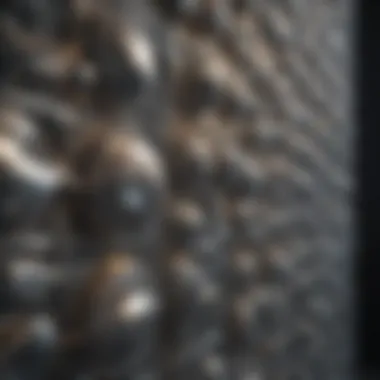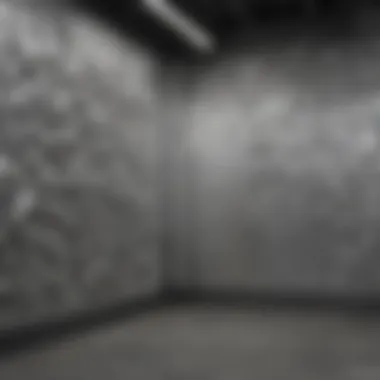Soundproof Membrane for Walls: An In-Depth Guide


Intro
Soundproof membranes serve as a crucial component in modern construction and renovation. Their primary purpose is to reduce sound transmission between spaces, making them essential for residential, commercial, and industrial applications. As urban environments grow denser, understanding effective soundproofing methods becomes increasingly important. The nuances of soundproof membranes, including their properties, installation techniques, and performance factors, warrant a thorough examination. This exploration provides a foundation for making informed decisions regarding soundproofing solutions.
Key Concepts and Terminology
Definition of Key Terms
To engage effectively with the topic, it is vital to define several key terms related to soundproof membranes.
- Soundproof Membrane: A specialized material designed to attenuate sound transmission through walls, ceilings, and floors.
- Sound Transmission Class (STC): A numerical rating that measures a material's effectiveness in reducing sound transmission. A higher STC rating indicates better soundproofing capabilities.
- Decibel (dB): A unit used to measure the intensity of sound.
Concepts Explored in the Article
In this comprehensive guide, various concepts will be discussed, including:
- The effectiveness of different types of soundproof membranes.
- Installation methods and best practices for optimizing performance.
- Key factors influencing sound transmission and absorption.
- Comparisons with traditional soundproofing methods such as acoustic panels and insulation.
- Long-term benefits and potential limitations of soundproof membranes.
Findings and Discussion
Main Findings
Research indicates that soundproof membranes significantly enhance quiet environments, especially in multi-unit dwellings. The materials vary widely, from rubberized composites to dense vinyl sheets. Typically, membranes with higher STC ratings outperform lower-rated alternatives in reducing noise. The installation process plays a critical role in overall performance, as gaps or incorrect positioning can compromise soundproofing efficacy.
Potential Areas for Future Research
Further exploration of innovative materials and technologies could lead to advancements in soundproofing solutions. Research could focus on developing eco-friendly membranes with comparable effectiveness. Additionally, studies assessing long-term performance and durability of various membranes can provide valuable insights into their practical applications. Understanding user experiences and preferences could also inform future product development in the soundproofing field.
"The selection of the right soundproofing membrane can transform a noisy space into an oasis of calm, enhancing comfort and productivity."
Prelims to Soundproofing
Soundproofing is a vital aspect of modern architecture and interior design. With the increasing density of urban living and the popularity of open-concept spaces, the necessity for noise control has become paramount. This section serves as a foundational overview, setting the stage for deeper inquiries into soundproof membranes. By understanding how soundproofing operates, stakeholders can make informed decisions when considering their options.
What is Soundproofing?
Soundproofing refers to techniques and materials used to reduce or eliminate sound transmission between spaces. It involves creating barriers that prevent sound waves from traveling through walls, floors, and ceilings. These methods range from structural changes, like adding thickness to walls, to the application of specific materials designed to absorb sound. Soundproofing is not only about noise prevention but also about creating a more comfortable environment. In residential settings, this can lead to reduced stress and improved sleep quality. In commercial spaces, effective soundproofing can enhance productivity by minimizing distractions.
Importance of Soundproofing in Modern Spaces
The importance of soundproofing in contemporary environments cannot be overstated. As we navigate through a world filled with constant auditory stimuli—from traffic to construction sounds—having a sanctuary becomes crucial. For residents, effective soundproofing can mean a peaceful home life, while for businesses, it can lead to enhanced focus and better communication. Research shows that excessive noise can negatively impact mental health and overall well-being. Hence, investing in soundproofing can yield long-term benefits, from mental tranquility to increased property values.
"Incorporating soundproofing solutions can transform spaces, enhancing both functionality and quality of life."
In summary, soundproofing is essential not only for privacy but also for fostering environments conducive to health and productivity. As we dive deeper into soundproof membranes specifically, understanding these foundational concepts will provide clarity on their role in modern construction and renovations.
Understanding Soundproof Membranes
Understanding soundproof membranes is crucial as they play a significant role in enhancing sound insulation in various environments. These membranes are designed to reduce the transmission of sound waves, making spaces more comfortable for both living and working. This section will explore the definition, composition, and materials of soundproof membranes, as well as their relevance in different contexts.
Definition of Soundproof Membranes
Soundproof membranes are specialized materials used to block or reduce sound transmission through walls, floors, and ceilings. They function by adding mass and dampening sound waves. Simply put, these membranes are barriers that limit the penetration of sound from one room to another. Their use is critical in residential, commercial, and industrial settings where noise levels can be disruptive.
Composition and Materials Used
The composition of soundproof membranes determines their effectiveness in soundproofing applications. Different materials exhibit unique properties that make them suitable for specific uses. Understanding these materials helps in making informed choices based on the project's requirements.
Polyvinyl Chloride (PVC)
Polyvinyl Chloride, commonly known as PVC, is a widely used material in soundproof membranes. Its key characteristic is durability, which ensures that it remains effective in the long term. PVC is advantageous due to its water resistance and ease of installation. However, it may not provide the same level of sound dampening as heavier materials. A unique feature of PVC membranes is their flexibility, allowing them to fit in various wall applications without requiring extensive modifications. In terms of disadvantages, prolonged exposure to sunlight can degrade PVC over time, limiting its lifespan in outdoor settings.
Mass Loaded Vinyl ()
Mass Loaded Vinyl is another popular choice for soundproofing. This material is dense and heavy, which enhances its ability to block sound. The key characteristic of MLV is its high mass per unit area, which effectively decreases sound transmission. MLV is frequently used in both residential and commercial applications due to its effectiveness and versatility. One unique feature of MLV is its ability to be installed in various configurations, making it suitable for both new constructions and renovations. Nevertheless, it can be more expensive than other options, which is a consideration for budget-conscious projects.
Universally Applied Membranes
Universally applied membranes are designed for a broad range of applications. These membranes can be made from various materials, including a blend of PVC and MLV, which provides a balance of flexibility and density. The key characteristic that sets universally applied membranes apart is their adaptability to different environments and soundproofing needs. They are beneficial for their ease of installation and effective sound dampening properties. However, the trade-off may be in their lower sound isolation compared to more specialized options.
"Selecting the right type of soundproof membrane is essential for achieving desired acoustic conditions in any space."
In summary, understanding the characteristics and applications of Polyvinyl Chloride, Mass Loaded Vinyl, and Universally Applied Membranes is critical for effective soundproofing solutions. Each material offers its advantages and limitations, influencing the decision on which to use for specific soundproofing projects.
How Soundproof Membranes Work


Understanding how soundproof membranes function is essential for assessing their effectiveness and application in various environments. Soundproof membranes are engineered to minimize sound transfer. This ability is key in both residential and commercial settings where noise reduction is a priority. The ideal soundproof membrane can reduce noise pollution significantly, leading to more comfortable and private spaces.
Principles of Sound Transmission
Sound transmission involves the way sound travels from one area to another. It occurs through various mediums, including air, solids, and liquids. The primary concepts surrounding sound transmission include the frequency of sound waves, the medium through which they travel, and the structural properties of the materials implicated.
Sound can travel through walls, ceilings, and floors. Factors that contribute to sound transmission include the density and mass of materials, the frequency of the sound, and any gaps or openings in structures. Soundproof membranes leverage their physical characteristics to disrupt this transmission, effectively blocking or absorbing sound waves before they penetrate the intended space.
Mechanics of Soundproof Membranes
The mechanics of soundproof membranes rely on two critical factors: mass and density, and damping and vibration isolation.
Mass and Density
Mass and density are vital aspects of soundproofing. Heavy materials can effectively hinder sound waves, preventing them from traveling through structures. Soundproof membranes, often made from dense materials like Mass Loaded Vinyl, utilize this principle. The key characteristic of mass in soundproof membranes is its ability to absorb and reflect sound waves.
This is beneficial for soundproofing as higher mass can lead to a better Sound Transmission Class (STC) rating. However, using heavy materials might pose installation challenges. Finding a balance between performance and practicality is essential when considering mass and density in the application of soundproof membranes.
Damping and Vibration Isolation
Damping refers to a material's ability to absorb sound energy and transform it into a small amount of heat. This reduces the sound waves’ intensity. Vibration isolation is associated with preventing vibrations from traveling through walls and other structural elements. Together, these elements contribute greatly to overall soundproofing effectiveness.
The unique feature of damping is its ability to minimize resonances within a building, helping to maintain quieter environments. This characteristic makes damping a crucial component in soundproof membranes. However, it may require specific installation methods to achieve optimal results, which could lead to increased costs and labor. Ultimately, damping and vibration isolation offer substantial advantages in creating peaceful and productive spaces.
"The effectiveness of soundproof membranes directly ties to how well they integrate mass, damping, and isolation principles."
Installation of Soundproof Membranes
The installation of soundproof membranes holds significant relevance in achieving effective sound insulation in various environments. This process is not merely about placing materials on walls, but also involves careful considerations about the overall performance and longevity of the soundproofing results. Proper installation enhances the effectiveness of the soundproof membranes, ensuring that sound transmission is minimized to the greatest extent possible.
Preparation of Wall Surfaces
Before installing soundproof membranes, it is essential to prepare wall surfaces adequately. This preparation impacts the adherence of the membranes to the walls and determines the overall effectiveness of the soundproofing effort.
Key steps in this preparatory phase include:
- Cleaning the surfaces: Remove dust, grease, or any other contaminants that might affect adhesion.
- Inspecting for damage: Address any cracks or holes that may allow sound leakage, as these can compromise the performance of the membranes.
- Leveling the surface: Ensure the wall is flat and free from protrusions to provide a uniform application surface for the membranes.
Proper surface preparation not only improves the installation process but also sustains the long-term effectiveness of the soundproofing solution.
Methods of Installation
Several methods can be adopted for the installation of soundproof membranes, each offering different advantages depending on the specific setting and requirements.
Direct Application Techniques
Direct application techniques involve adhering soundproof membranes directly onto wall surfaces. This method is often favored for its simplicity and direct approach.
The key characteristic of this technique is its straightforwardness. It allows for quick installation without the need for extensive additional framing or structural modifications.
Unique features of direct application techniques include:
- Immediate impact: As soon as the membrane is applied, sound attenuation begins.
- Cost-effectiveness: It typically requires fewer materials and labor than more complex methods.
However, this method may face limitations regarding the thickness of the membrane, as thicker membranes can create space issues in smaller rooms.
Adhering to Existing Walls
Adhering soundproof membranes to existing walls offers a versatile method that can significantly enhance sound insulation in pre-existing structures. This is particularly useful in older buildings where demolition is not feasible.
A notable characteristic of this approach is the minimal disturbance it causes to the building's existing layout.
Unique features of adhering to existing walls include:
- Efficiency: It can be completed relatively quickly, making it a ideal for renovations.
- Flexibility: Suitable for various wall types, from drywall to concrete.
The disadvantage lies in the potential need for wall repairs before application and, in some cases, less optimal adherence if the existing wall surface is not in good condition.
Integration with Framing Systems
Integration with framing systems represents a more complex installation approach where soundproof membranes are fitted within the framing structure of the wall itself. This method is particularly effective in new constructions or significant renovations.
The fundamental strength of this method is its ability to integrate soundproofing directly into the building's design.
Unique features of integration with framing systems include:


- Enhanced performance: Allows for the use of thicker membranes, thereby improving sound insulation capabilities.
- Structural benefits: The framing can be optimized for soundproofing, reducing overall sound transmission.
However, this method often involves higher costs and longer installation times, which can be a drawback for some projects.
In summary, the approach taken during the installation of soundproof membranes greatly influences the soundproofing effectiveness of a given space. The choices between direct application, adhering to existing walls, and integrating with framing systems each come with unique benefits and considerations that affect performance, cost, and installation time.
Effectiveness of Soundproof Membranes
The effectiveness of soundproof membranes is crucial in understanding their role in modern soundproofing solutions. These membranes provide various benefits, making them appealing for both residential and commercial spaces. Their ability to reduce sound transmission enhances privacy and comfort, addressing a common issue faced in densely populated environments.
Evaluating Sound Transmission Class (STC) Ratings
Sound Transmission Class (STC) is a critical metric used to evaluate soundproofing materials. The STC rating indicates how well a material can block sound. A higher STC rating implies better sound insulation. For example, wall assemblies with an STC rating of 50 or above are often sufficient for most residential needs. This measurement assists in making informed decisions about using soundproof membranes, as it directly correlates with their effectiveness.
Factors Influencing Performance
Type of Wall Structure
The type of wall structure plays a significant role in the effectiveness of soundproof membranes. Different wall types, whether they are drywall, concrete, or masonry, affect how sound waves travel. Drywall, for instance, is popular due to its light weight and ease of installation. When soundproof membranes are added to drywall, they can enhance STC ratings effectively.
However, solid walls like concrete can already provide substantial sound isolation. Introducing soundproof membranes may not have as much impact as in lighter wall structures. Therefore, understanding the wall type will inform the choice of soundproofing solutions.
Membrane Thickness
Membrane thickness is another vital factor influencing soundproofing performance. Thicker membranes generally provide better sound absorption. For example, a 1/8 inch thick membrane may be sufficient for general use, while thicker options, such as 1/4 inch, can offer superior sound isolation. The added mass assists in dampening vibrations, which is essential in reducing noise transmission.
However, thicker membranes can be more challenging to install due to weight and flexibility. Therefore, there is a trade-off between soundproofing benefits and practical application during installation.
Environmental Considerations
Environmental considerations also influence the effectiveness of soundproof membranes. When it comes to sustainability, some membranes are more eco-friendly than others. Materials like Mass Loaded Vinyl are durable but can have environmental drawbacks during disposal. In contrast, some new products are designed to be more recyclable, responding to growing consumer demand for sustainable building materials.
Furthermore, the insulation properties of membranes may be impacted by temperature and humidity, which are essential to address in various climates. This adaptability can either enhance or diminish their effectiveness, depending on where they are installed.
"Choosing the appropriate soundproof membrane can significantly impact both sound reduction and environmental sustainability."
Comparative Analysis of Soundproofing Methods
In this section, we engage in a detailed examination of various soundproofing methods. Understanding different approaches is vital for making informed choices regarding soundproofing solutions. Each method comes with its own advantages and disadvantages, making it essential to explore their relative effectiveness, costs, and applications.
Soundproof Membranes vs. Traditional Soundproofing
When assessing soundproof membranes, it is essential to compare them against traditional soundproofing techniques. Traditional methods include insulation materials like fiberglass, acoustic panels, and resilient channels. These methods often focus on mass and density to block sound waves. However, their installation can be labor-intensive and less effective in certain scenarios.
Soundproof membranes, such as Mass Loaded Vinyl, offer a thinner profile than most traditional materials. Their flexible nature allows for easier application on walls without the need for extensive construction work. Key considerations when comparing these methods include:
- Efficiency: Soundproof membranes can provide higher sound reduction with less physical mass compared to heavier traditional materials.
- Versatility: Membranes can adapt to different wall types and structures.
- Aesthetics: Using membranes ensures that the visual integrity of spaces is maintained, as they can be easily covered with other materials.
Traditional methods might perform better in specific environments where complete sound isolation is fixed. However, the lower profile of soundproof membranes allows for a more manageable installation process without compromising on efficiency.
"In many contexts, less is more. Soundproof membranes often outperform traditional methods despite being lighter and slimmer."
Cost-Effectiveness of Various Solutions
Cost plays a significant role in deciding between different soundproofing methods. Soundproof membranes generally emerge as a more cost-effective solution in specific applications. The initial costs for materials and installations are lower when compared to traditional methods that require more labor and resources.
When considering cost-effectiveness, it is crucial to look at the following factors:
- Material Costs: Soundproof membranes often have a comparable price per square foot to traditional materials yet offer better performance with less weight.
- Installation Time: The quicker installation process of membranes reduces labor costs significantly.
- Long-Term Value: Investing in soundproof membranes can yield long-term savings by reducing sound pollution, improving comfort, and potentially increasing property value.
In summary, the comparative analysis of soundproofing methods illustrates that soundproof membranes can be as effective, if not more so, than traditional soundproofing methods. Their flexibility, lower profile, reduced costs, and efficiency make them a compelling choice in both residential and commercial contexts.
Applications of Soundproof Membranes
Soundproof membranes play a critical role in creating quieter environments, an essential consideration in both residential and commercial sectors. Their usage transcends mere noise reduction; it enhances the overall quality of life and productivity. As urban spaces grow increasingly noisy, the significance of soundproof membranes becomes more apparent. They can effectively manage sound transmission, ensuring that peace and quiet can be achieved even in bustling areas.
In this section, we explore various applications of soundproof membranes, allowing readers to see the versatile benefits these materials offer. From the home to industries, soundproof membranes minimize disruption and foster more harmonious spaces. Understanding these applications encourages informed choices for those looking to create serene environments.
Residential Uses
In residential settings, soundproof membranes provide an avenue for homeowners to combat noise pollution from urban surroundings. These membranes can reduce sound coming from outside, as well as internal noise from other rooms.
One significant benefit is privacy; especially in shared living arrangements or multi-story homes. Families can enjoy their leisure activities without disturbing others or being disturbed themselves. The thickness and material of the membranes often dictate their effectiveness. An alternative approach is incorporating soundproof membranes during renovations, offering a boost to existing walls without extensive modifications.
Commercial Applications


Office Spaces
In office spaces, the application of soundproof membranes is particularly noteworthy. Noise distraction can significantly hinder productivity and concentration. Soundproof membranes create an environment conducive to focused work. Their installation helps in maintaining confidentiality during meetings, enhancing professional interactions.
Key characteristics of office spaces include open-plan designs. This feature makes sound insulation even more crucial, as noise travels easily between workstations. Thus, using soundproof membranes becomes a popular solution. Employees benefit from reduced fatigue and stress levels due to a more controlled sound environment.
Unique features of soundproof membranes in these settings often involve their adaptability to different types of office layouts. However, limitations may exist regarding installation in existing structures. It requires careful planning to integrate effectively into the space.
Recording Studios
Recording studios present a specialized case for soundproof membranes. In such environments, capturing audio with utmost clarity is paramount. Thus, noise isolation is essential to achieve high-quality recordings.
The unique characteristic of recording studios is their need for perfect sound control. Soundproof membranes address this need by preventing external sounds from interfering with recordings. They absorb reverberations and vibrations, ensuring a clean sound canvas. This makes them a beneficial choice in the recording arts.
One advantage is the flexibility of design when using soundproof membranes. They can be installed in walls, ceilings, and floors, allowing for improved acoustics throughout. However, one potential disadvantage is the cost associated with high-quality materials. Investing in superior soundproofing can mean higher initial expenses.
Industrial Contexts
Industrial contexts often require robust soundproofing solutions to meet regulatory standards. Machinery and equipment can generate substantial noise, impacting worker safety and comfort. Here, soundproof membranes serve to limit exposure to excessive sound levels, protecting workers' hearing and well-being.
These membranes can be integrated into existing structures during renovations. Alternatively, they can be part of new builds, enhancing overall sound isolation from the start. Industrial applications often demand materials that can withstand challenging environments. Therefore, durability and performance are crucial considerations when selecting soundproof membranes for these settings.
Limitations of Soundproof Membranes
Soundproof membranes have become integral in the field of acoustic treatment, providing significant noise reduction in both residential and commercial environments. However, they are not without their constraints. Understanding these limitations is essential for making informed decisions regarding soundproofing solutions. Key aspects include physical limitations, trade-offs, and environmental impacts, each influencing the overall effectiveness and sustainability of soundproof membranes.
Physical Limitations and Trade-offs
Soundproof membranes are effective in reducing sound transmission, but physical limitations exist. One major limitation is their reliance on mass and density to counteract sound vibrations. While materials like Mass Loaded Vinyl (MLV) offer significant sound isolation, they cannot eliminate all sound frequencies equally. For example, low-frequency sounds often penetrate through membranes, especially if they are not adequately thick or correctly installed.
The installation process itself can also present trade-offs. Adhering these membranes properly may require modifications to existing wall structures. This can involve additional costs and labor, which can be deterrents for some users. Furthermore, the overall aesthetic of the space may be compromised since soundproofing materials may add bulk to walls or ceilings.
Finally, the effectiveness of soundproof membranes may decrease over time if not maintained properly. Exposure to moisture or shifting building structures can lead to degradation. Regular maintenance is therefore necessary, as neglecting it can compromise their soundproofing capabilities and lead to further noise issues.
Potential Environmental Impact
When evaluating soundproof membranes, it is critical to consider the environmental impact of production, use, and disposal. Many soundproofing materials contain synthetic substances, which can emit volatile organic compounds (VOCs) into the air. This can affect indoor air quality, with implications for health in homes or workplaces.
In addition to VOCs, the production of such materials often involves resource-intensive processes. The extraction of raw materials, manufacturing, and transportation contribute to carbon footprints, raising sustainability questions. Users must balance soundproofing effectiveness with eco-friendliness.
Disposal of soundproof membranes can also pose challenges. Many are not biodegradable and require special consideration during removal. Improper disposal can lead to landfill overflow, contributing to long-term environmental harm.
Long-Term Maintenance and Sustainability
Long-term maintenance and sustainability are crucial aspects when considering soundproof membranes for walls. These factors not only influence the longevity and performance of the membranes but also their overall environmental impact. Understanding how to maintain these materials effectively can lead to enhanced soundproofing without needing frequent replacements or repairs.
Durability and Lifespan of Membranes
Soundproof membranes are designed to withstand significant wear and tear. The durability of these materials can vary based on composition, type, and environmental factors. For instance, membranes such as Mass Loaded Vinyl (MLV) show strong resistance to environmental changes and can last many years if properly installed.
Key points to consider include:
- Material Quality: Higher quality membranes typically offer better durability.
- Environmental Factors: Exposure to moisture and temperature fluctuations can affect lifespan.
- Installation Quality: Proper installation methods can prevent early degradation.
Ensuring that the membranes have a long lifespan requires regular inspections. Check for any signs of wear, especially in places prone to damage, such as edges and joints.
Recycling and Disposal Considerations
As awareness about environmental issues grows, the ability to recycle soundproof membranes becomes increasingly important. Most soundproof membranes are not biodegradable, leading to potential landfill problems. Hence, understanding how to recycle or dispose of these materials responsibly can significantly reduce their environmental footprint.
Considerations regarding recycling and disposal include:
- Material Composition: Some membranes are made from recyclable materials. Identifying these can guide proper disposal methods.
- Local Regulations: Checking local policies on construction waste can provide clarity on how to manage soundproof membranes at the end of their lifespan.
- Manufacturer Take-back Programs: Some manufacturers offer programs to recycle or repurpose old membranes, which can be a sustainable option.
Adopting sustainable practices when dealing with soundproof membranes ultimately contributes to a better environmental outcome and supports the idea of responsible production and consumption.
End and Future Perspectives
The role of soundproof membranes in modern architecture and construction cannot be overstated. As urban environments grow denser, the need for effective soundproofing solutions becomes increasingly relevant. In this article, we have explored the intricate details of soundproof membranes, analyzing their composition, installation methods, and practical applications.
Summary of Key Insights
The exploration of soundproof membranes reveals several critical insights that resonate across various sectors. Here are the key takeaways:
- Soundproof membranes come in various materials, such as Polyvinyl Chloride (PVC) and Mass Loaded Vinyl (MLV).
- Their effectiveness is influenced by factors like membrane thickness and wall structure.
- Installation methods can vary, allowing for adaptability to existing structures.
- Evaluating STC ratings provides a useful benchmark for measuring soundproofing effectiveness.
Understanding these elements offers valuable guidance for both professionals and DIY enthusiasts embarking on soundproofing projects. As more individuals and companies begin to prioritize acoustic comfort, the demand for expertly designed soundproof membranes is likely to rise.
"A well-designed soundproofing solution can enhance not only privacy but also overall quality of life."
Emerging Trends in Soundproofing Technology
As we look towards the future of soundproof technology, several trends stand out. Innovations continue to emerge that promise to enhance the capabilities of soundproof membranes:
- Smart Materials: The integration of technology into materials offers dynamic sound control, adapting to environmental changes or usage patterns.
- Eco-friendly options: Increasing awareness of environmental concerns has led to the development of sustainable soundproof membranes, with lower environmental impact during production and disposal.
- Increased customization: Tailored solutions cater to specific acoustical needs in various settings, from homes to recording studios.
These trends not only highlight the ongoing evolution in soundproofing solutions but also present opportunities for further research and development. As soundproof technologies advance, we can expect them to become more efficient and effective, catering to the ever-growing need for quieter spaces.







